
Tel: 020 7620 1818 email: cookandbutler@btconnect.com
The Worshipful Company of Fuellers
www.fuellers.co.uk
Affiliates Luncheon & Prizegiving
June 2025, Trinity House, City of London
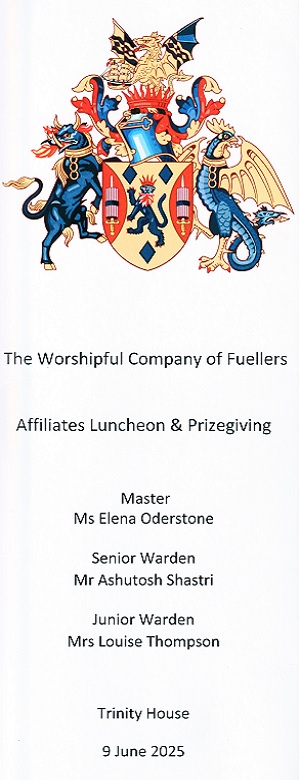
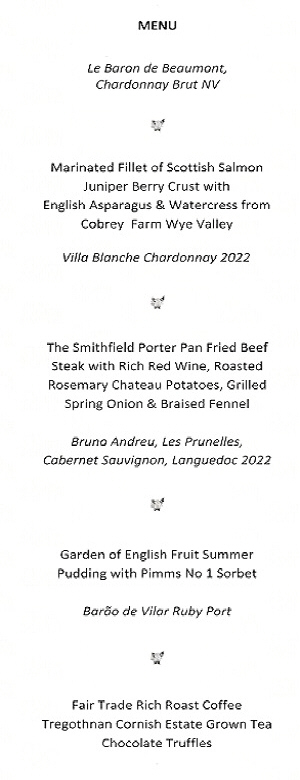
![]()
The Great Fire of London Remembered - an Evening with Samuel Pepys
June 2016, Bakers' Hall, London
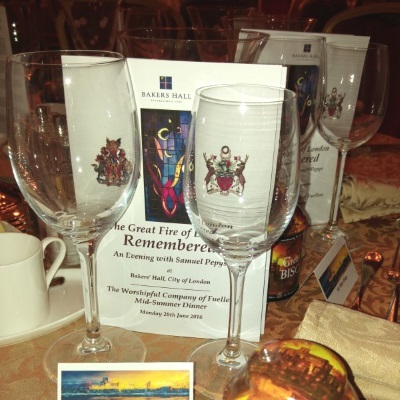
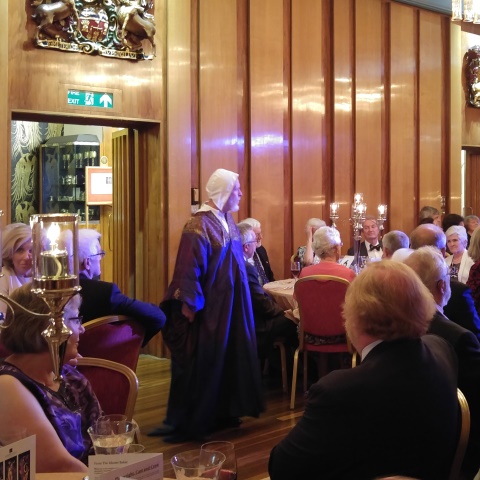
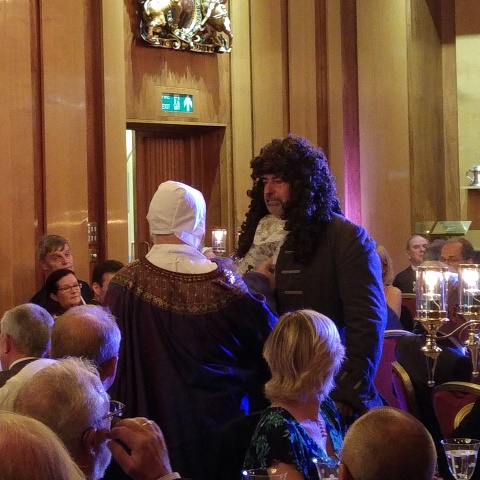
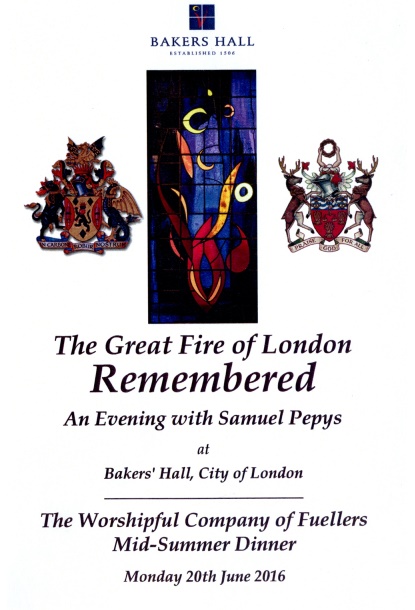
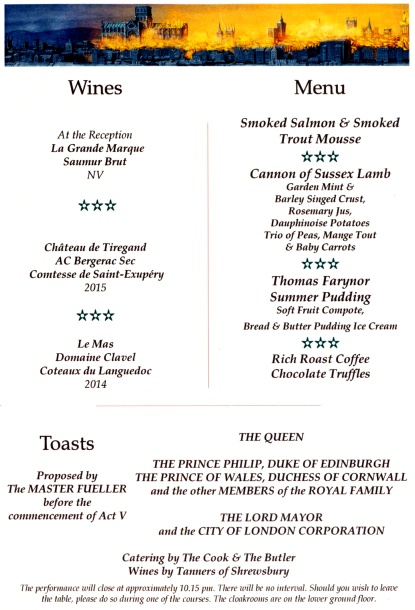
Menu cover design based on the famous John Piper stained glass windows
depicting the loss of three Bakers' Halls
to fire — the Great Fire of 1666, the Thames Street fire of 1715, and
the Second World War Blitz of 1940
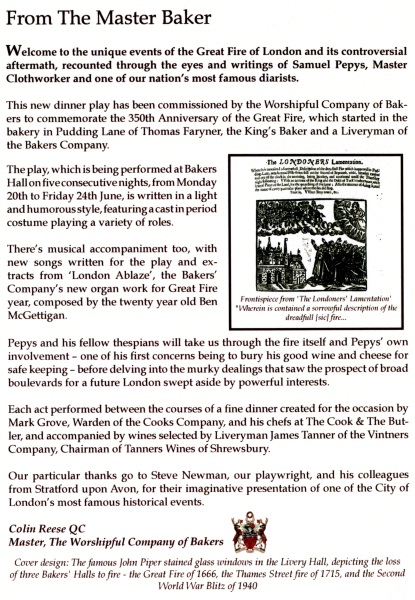
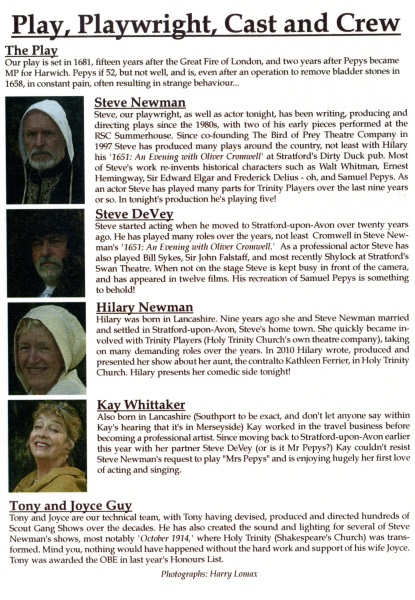

From The Master Baker
Welcome to the unique events of the Great Fire of
London and its controversial aftermath, recounted through the eyes and
writings of Samuel Pepys, Master Clothworker and one of our nation's
most famous diarists. This new dinner play has been commissioned by the
Worshipful Company of Bakers to commemorate the 350th Anniversary of the
Great Fire, which started in the bakery in Pudding Lane of Thomas
Faryner, the King's Baker and a Liveryman of the Bakers Company.
The play, which is being performed at Bakers Hall on five consecutive
nights, from Monday 20th to Friday 24th June, is written in a light and
humorous style, featuring a cast in period costume playing a variety of
roles.
There's musical accompaniment too, with new songs written for the play
and extracts from 'London Ablaze', the Bakers' Company's new organ work
for Great Fire year, composed by the twenty year old Ben McGettigan.
Pepys and his fellow thespians will take us through the fire itself and
Pepys' own involvement — one of his first concerns being to bury his
good wine and cheese for safe keeping — before delving into the murky
dealings that saw the prospect of broad boulevards for a future London
swept aside by powerful interests.
Each act performed between the courses of a fine dinner created for the
occasion by Mark Grove, Warden of the Cooks Company, and his chefs at
The Cook & The Butler, and accompanied by wines selected by Liveryman
James Tanner of the Vintners Company, Chairman of Tanners Wines of
Shrewsbury.
Our particular thanks go to Steve Newman, our playwright, and his
colleagues from Stratford upon Avon, for their imaginative presentation
of one of the City of London's most famous historical events.
Colin Reese QC Master, The Worshipful Company of Bakers

Royal Charter Banquet,
March 2015, Guildhall, City of London
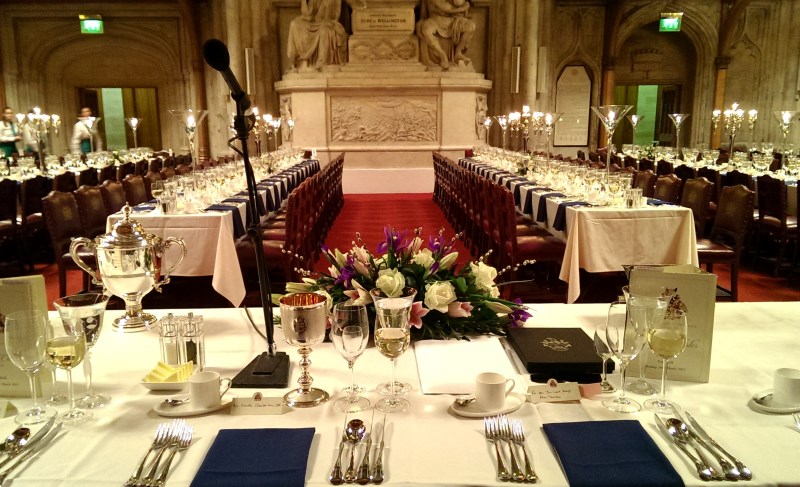
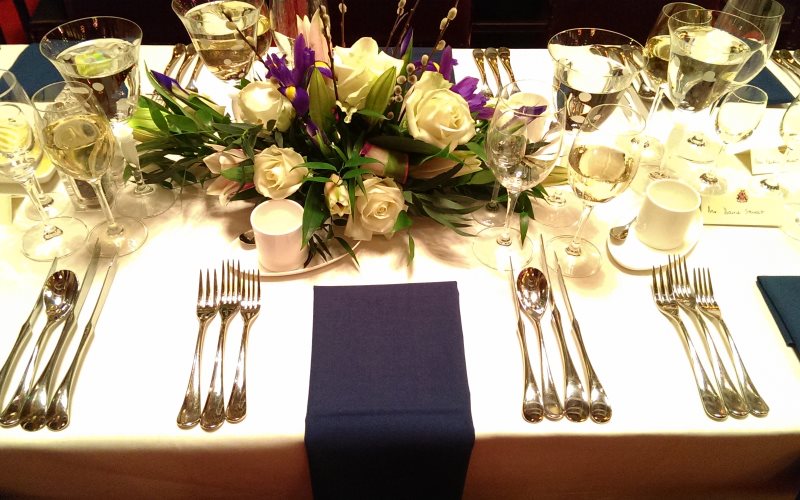
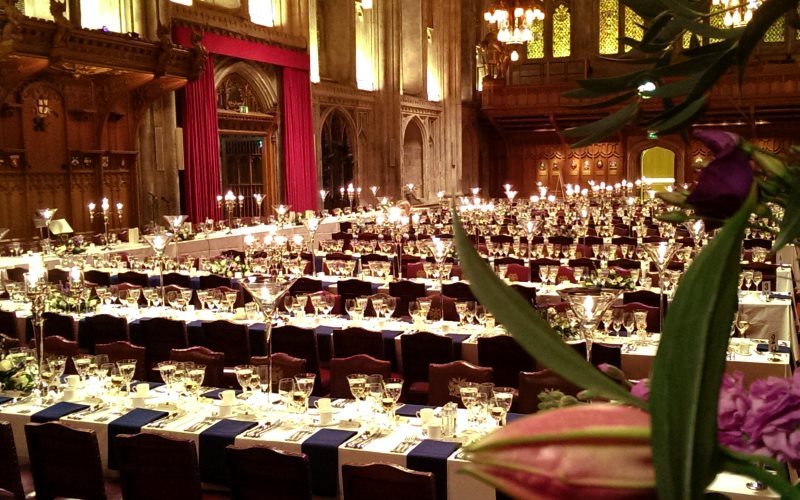
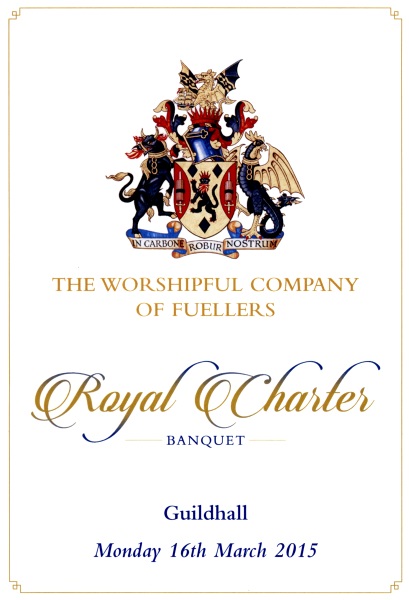
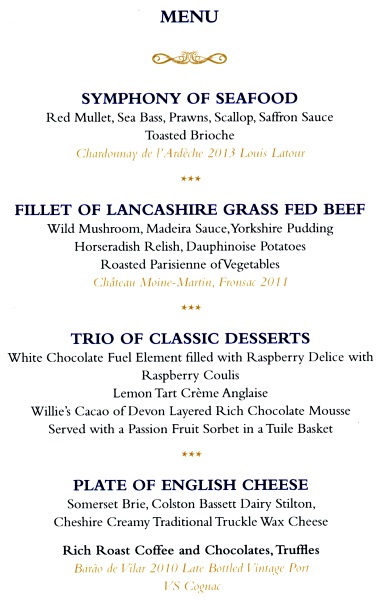
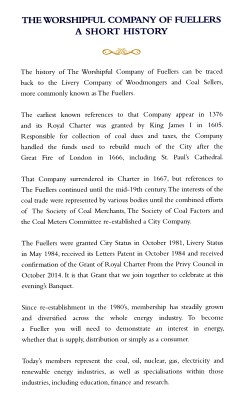
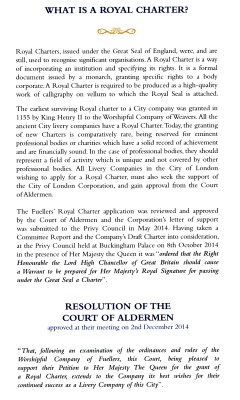
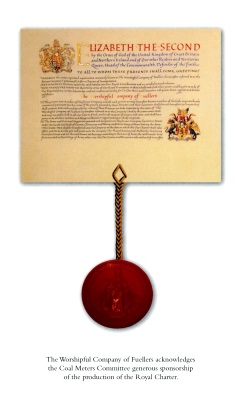

THE WORSHIPFUL COMPANY OF FUELLERS - A SHORT HISTORY
The history of The Worshipful Company of Fuellers can
be traced back to the Livery Company of Woodmongers and Coal Sellers,
more commonly known as The Fuellers.
The earliest known references to that Company appear in 1376 and its
Royal Charter was granted by King James I in 1605. Responsible for
collection of coal dues and taxes, the Company handled the funds used to
rebuild much of the City after the Great Fire of London in 1666,
including St. Paul's Cathedral.
That Company surrendered its Charter in 1667, but references to The
Fuellers continued until the mid-19th century. The interests of the coal
trade were represented by various bodies until the combined efforts of
The Society of Coal Merchants, The Society of Coal Factors and the Coal
Meters Committee re-established a City Company.
The Fuellers were granted City Status in October 1981, Livery Status in
May 1984, received its Letters Patent in October 1984 and received
confirmation of the Grant of Royal Charter From the Privy Council in
October 2014. It is that Grant that we join together to celebrate at
this evening's Banquet. Since re-establishment in the 1980's, membership
has steadily grown and diversified across the whole energy industry. To
become a Fueller you will need to demonstrate an interest in energy,
whether that is supply, distribution or simply as a consumer.
Today's members represent the coal, oil, nuclear, gas, electricity and
renewable energy industries, as well as specialisations within those
industries, including education, finance and research.

WHAT IS A ROYAL CHARTER?
Royal Charters, issued under the Great Seal of
England, were, and are still, used to recognise significant
organisations. A Royal Charter is a way of incorporating an institution
and specifying its rights. It is a formal document issued by a monarch,
granting specific rights to a body corporate. A Royal Charter is
required to be produced as a high-quality work of calligraphy on vellum
to which the Royal Seal is attached.
The earliest surviving Royal charter to a City company was granted in
1155 by King Henry II to the Worshipful Company of Weavers. All the
ancient City livery companies have a Royal Charter. Today, the granting
of new Charters is comparatively rare, being reserved for eminent
professional bodies or charities which have a solid record of
achievement and are financially sound. In the case of professional
bodies, they should represent a field of activity which is unique and
not covered by other professional bodies. All Livery Companies in the
City of London wishing to apply for a Royal Charter, must also seek the
support of the City of London Corporation, and gain approval from the
Court of Aldermen.
The Fuellers' Royal Charter application was reviewed and approved by the
Court of Aldermen and the Corporation's letter of support was submitted
to the Privy Council in May 2014. Having taken a Committee Report and
the Company's Draft Charter into consideration, at the Privy Council
held at Buckingham Palace on 8th October 2014 in the presence of Her
Majesty the Queen it was "ordered that the Right Honourable the Lord
High Chancellor of Great Britain should cause a Warrant to be prepared
for Her Majesty's Royal Signature for passing under the Great Seal a
Charter".
RESOLUTION OF THE COURT OF ALDERMEN
approved at their meeting on 2nd December 2014
"That, following an examination of the ordinances and rules of the Worshipful Company of Fuellers, this Court, being pleased to support their Petition to Her Majesty The Queen for the grant of a Royal Charter, extends to the Company its best wishes for their continued success as a Livery Company of this City".

New Year Court
Dinner
January 2014, Cutlers' Hall, London
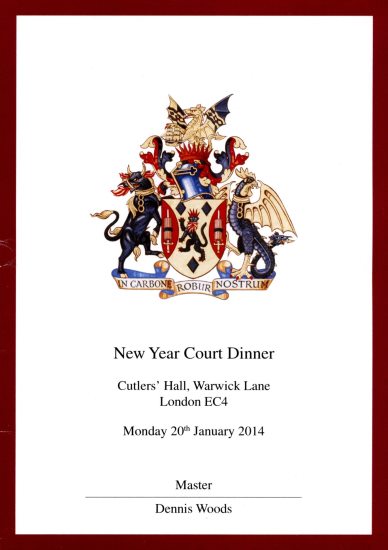
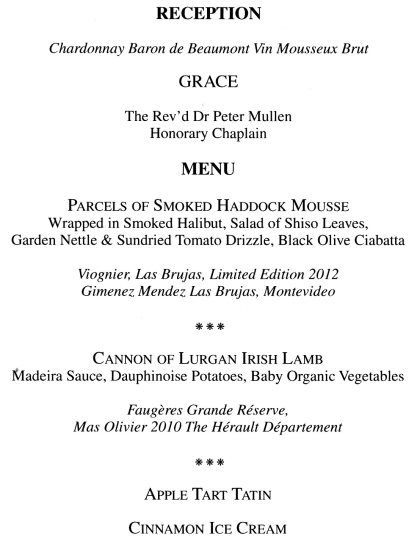

Cutlers' Hall
The Cutlers' Company is one of the most ancient
of the City of London livery companies and received its first Royal
Charter from Henry V in 1416. As was the case with the other trade
guilds of the day, its function was to protect the interests of its
members, to attend to their welfare, and to ensure that high standards
of quality were maintained. Their business was producing and
trading in knives, swords, and other implements with a cutting edge.
A 'House of the Cutlers', mentioned in 128S as being on or near
Cheapside, is the earliest recorded regular meeting place of the
Cutlers. By the early part of the 15th century the Cutlers were settled
in a building in what is now Cloak Lane (by Cannon St. Station). The
Company still holds the Conveyance of that Hall which describes the
property as being 'next to the tenement formerly belonging to the famous
Richard Whityngton, sometime Mayor'.
The Hall was quite substantial and had a garden with a well and a vinery.
In 1660, after some 250 years, the Hall was in need of extensive repairs
and modernisation, and it was determined to rebuild it completely. By
June 1666 the final bills had all been paid, but three months later it
was completely destroyed in the Great Fire of London. The Company
quickly set about rebuilding and the new Hall was ready for use in
September 1670. This Hall was occupied for over 200 years until 1882
when the District Railway acquired most of the site by compulsory
purchase. The fifth and present Hall was built on land in Warwick Lane,
which had been the site of the Royal College of Physicians from 1674 to
1825 and subsequently a foundry. The new Hall came into use on March 7th
1888.
Nowadays the Company is dedicated to charitable work and raises
significant sums for educational scholarships, medical research, the
hospice movement and elephant protection charities in India and Africa.
To view and order photographs of this evening please refer to
www.michaelosullivan.co.uk —
online gallery
![]()